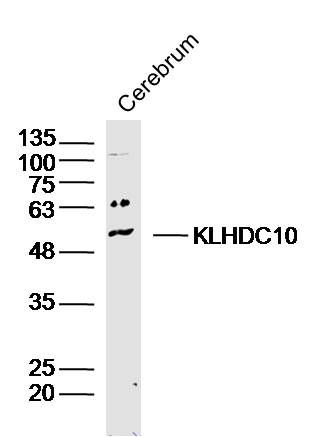产品货号 : mlR16757
英文名称 : KLHDC10
中文名称 : KLHDC10蛋白抗体
别 名 : Kelch domain containing 10; Kelch domain-containing protein 10; KIAA0265; KLD10_HUMAN; Klhdc10; OTTHUMP00000212347; PNAS 119; Scruin like at the midline homolog; Slim.
研究领域 : 细胞生物 免疫学 神经生物学
抗体来源 : Rabbit
克隆类型 : Polyclonal
交叉反应 : Human, Mouse, Rat, Cow, Rabbit, Sheep,
产品应用 : WB=1:500-2000 ELISA=1:500-1000 IHC-P=1:400-800 IHC-F=1:400-800 ICC=1:100-500 IF=1:100-500 (石蜡切片需做抗原修复)
not yet tested in other applications.
optimal dilutions/concentrations should be determined by the end user.
分 子 量 : 49kDa
细胞定位 : 细胞核
性 状 : Lyophilized or Liquid
浓 度 : 1mg/ml
免 疫 原 : KLH conjugated synthetic peptide derived from human KLHDC10:1-100/442
亚 型 : IgG
纯化方法 : affinity purified by Protein A
储 存 液 : 0.01M TBS(pH7.4) with 1% BSA, 0.03% Proclin300 and 50% Glycerol.
保存条件 : Store at -20 °C for one year. Avoid repeated freeze/thaw cycles. The lyophilized antibody is stable at room temperature for at least one month and for greater than a year when kept at -20°C. When reconstituted in sterile pH 7.4 0.01M PBS or diluent of antibody the antibody is stable for at least two weeks at 2-4 °C.
PubMed : PubMed
产品介绍 : KLHDC10 is a 442 amino acid protein that contains six kelch repeats. Expressed in fetal brain, liver, lung, kidney and placenta, KLHDC10 exists as two alternatively spliced isoforms. The gene encoding KLHDC10 maps to human chromosome 7, which houses over 1,000 genes and comprises nearly 5% of the human genome. Chromosome 7 has been linked to Osteogenesis imperfecta, Pendred syndrome, Lissencephaly, Citrullinemia and Shwachman-Diamond syndrome. The deletion of a portion of the q arm of chromosome 7 is associated with Williams-Beuren syndrome, a condition characterized by mild mental retardation, an unusual comfort and friendliness with strangers and an elfin appearance. Deletions of portions of the q arm of chromosome 7 are also seen in a number of myeloid disorders, including cases of acute myelogenous leukemia and myelodysplasia.
Subunit:
Interacts with CUL2, TCEB1 and TCEB2; may be the substrate recognition component of an E3 ubiquitin ligase complex.
Subcellular Location:
Nucleus
Similarity:
Contains 6 Kelch repeats.
SWISS:
Q6PID8
Gene ID:
23008
Important Note:
This product as supplied is intended for research use only, not for use in human, therapeutic or diagnostic applications.
产品图片












